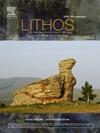Mesozoic highly oxidized and hydrous adakitic magmatism controlling porphyry Cu mineralization in NE China: Evidence from the Baoquan deposit
IF 2.9
2区 地球科学
Q2 GEOCHEMISTRY & GEOPHYSICS
引用次数: 0
Abstract
In northeastern China, Mesozoic porphyry Mo-dominated deposits are abundant but porphyry Cu deposits are rare. Investigating the mechanisms controlling the formation of the limited number of the porphyry Cu deposits is critical in understanding the regional Cu metallogeny. Here, we present geochronological and geochemical data for the Cu-mineralized and barren intrusions in the newly discovered Baoquan porphyry deposit in the northern Great Xing'an Range. Zircon U-Pb dating indicates that the mineralized quartz diorite porphyry and barren syenogranite were emplaced at ∼115 Ma and ∼312 Ma, respectively. The quartz diorite porphyry (SiO2 = 62.7–63.9 wt%) has high alkaline contents (Na2O + K2O = 6.82–8.28 wt%), is enriched in LILEs (K, Rb, Ba, and Sr) and depleted in HFSEs (Th, Nb, Ta, Zr and Ti), and exhibits low initial 87Sr/86Sr ratios (0.7049–0.7067) and positive εNd(t) values (+1.9 to +2.0), as well as positive zircon εHf(t) values (+4.9 to +13.6), indicating that the parental magma was predominantly derived from the mantle, likely metasomatized by fluids derived from the subducted Paleo-Pacific slab. In contrast, the barren syenogranite (SiO2 = 76.4–78.0 wt%) is depleted in Sr (40.6–82.4 ppm) and Ba (348–498 ppm), with high Zr + Y + Ce + Nb values (206–277 ppm), showing A-type granite affinities. The Baoquan ore-related porphyry is oxidized (ΔFMQ = +1.2 in average) as calculated using magmatic oxybarometer using trace elements in zircon, in contrast with that of the barren syenogranite with lower magmatic ΔFMQ values (+0.6 in average). The porphyry also has low Zr contents (average 151 ppm) and Sr/Zr ratios (average 7.96), consistent well with other Cu-fertile magmas. Additionally, it also displays adakitic signatures with relatively high Sr/Y ratios (78–130), low Dy/Yb ratios (1.86–2.03) and negligible Eu anomalies (Eu/Eu* = 0.79–0.96). These findings suggest that zircon and hornblende fractionation, rather than plagioclase separation, has dominated magma crystallization, further indicating a high magmatic water content. Together with previously published data for the other Cu-mineralized intrusions in NE China, it is proposed that the magmas with high oxygen fugacities and H2O contents that have experienced high-pressure fractionation are favorable for Cu mineralization. Notably, the intrusions with such characteristics are mainly distributed in the northern Great Xing'an Range characterized by thickened Mesozoic crust, where should be prioritized for future Cu exploration.
东北中生代高氧化含水埃达克岩岩浆作用控制斑岩型铜矿化:来自宝泉矿床的证据
中国东北中生代斑岩型钼矿床丰富,而斑岩型铜矿较少。研究数量有限的斑岩型铜矿床的形成机制对认识区域铜成矿作用具有重要意义。本文介绍了大兴安岭北部新发现的宝泉斑岩矿床中铜矿化和贫斑岩体的年代学和地球化学资料。锆石U-Pb测年表明,矿化石英闪长斑岩和贫正长花岗岩的侵位时间分别为~ 115 Ma和~ 312 Ma。石英闪长斑岩(SiO2 = 62.7 ~ 63.9 wt%)碱性含量高(Na2O + K2O = 6.82 ~ 8.28 wt%), LILEs (K、Rb、Ba、Sr)富集,hfse (Th、Nb、Ta、Zr、Ti)富集,初始87Sr/86Sr比值低(0.7049 ~ 0.7067),εNd(t)值正(+1.9 ~ +2.0),锆石εHf(t)值正(+4.9 ~ +13.6),表明母岩浆主要来源于地幔;可能是由俯冲的古太平洋板块产生的流体交代的。秃正长花岗岩(SiO2 = 76.4 ~ 78.0 wt%)贫Sr (40.6 ~ 82.4 ppm)和Ba (348 ~ 498 ppm),高Zr + Y + Ce + Nb值(206 ~ 277 ppm),具有a型花岗岩亲和力。利用锆石中微量元素的岩浆氧气压表计算得出,宝泉矿伴生斑岩的氧化值(ΔFMQ = +1.2平均值)与正长花岗岩的氧化值(ΔFMQ = +0.6平均值)相对较低。该斑岩具有较低的Zr含量(平均为151 ppm)和Sr/Zr比值(平均为7.96),与其他富铜岩浆具有较好的一致性。此外,它还具有较高的Sr/Y比值(78 ~ 130),较低的Dy/Yb比值(1.86 ~ 2.03)和可忽略的Eu异常(Eu/Eu* = 0.79 ~ 0.96)。这些发现表明,岩浆结晶主要是锆石和角闪石分选作用,而不是斜长石分选作用,进一步表明岩浆含水量较高。结合前人对中国东北其他铜成矿侵入体的资料,认为高氧逸度和高水含量岩浆经历高压分馏有利于铜成矿。值得注意的是,具有此类特征的侵入体主要分布在大兴安岭北部中生代地壳增厚的地区,应成为今后铜勘探的重点。
本文章由计算机程序翻译,如有差异,请以英文原文为准。
求助全文
约1分钟内获得全文
求助全文
来源期刊

Lithos
地学-地球化学与地球物理
CiteScore
6.80
自引率
11.40%
发文量
286
审稿时长
3.5 months
期刊介绍:
Lithos publishes original research papers on the petrology, geochemistry and petrogenesis of igneous and metamorphic rocks. Papers on mineralogy/mineral physics related to petrology and petrogenetic problems are also welcomed.
 求助内容:
求助内容: 应助结果提醒方式:
应助结果提醒方式:


